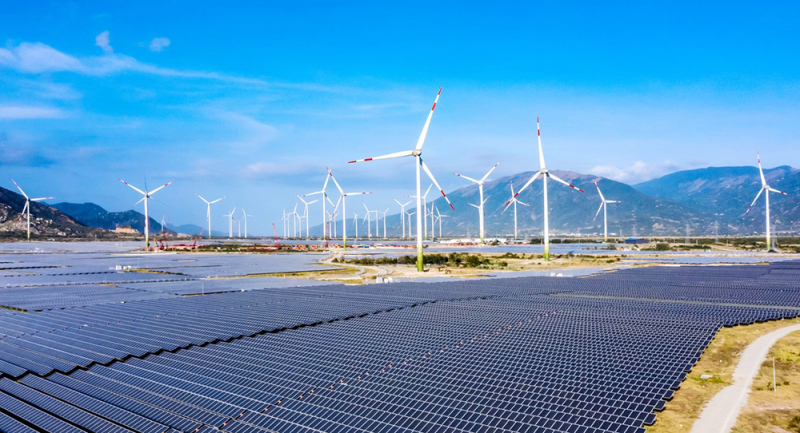Vietnam plans to develop two inter-regional renewable energy industrial and service hubs in the Northern region and the South Central – Southern regions. These hubs will integrate equipment manufacturing, research and training, and logistics services, forming a complete value chain and enhancing Vietnam’s competitiveness on the global renewable energy map.
Strong Increase in Clean Energy, Boosting Electricity Exports
The Ministry of Industry and Trade has issued an implementation plan for the revised National Power Development Plan for the 2021–2030 period, with a vision to 2050 (referred to as the adjusted Power Development Plan VIII Implementation Plan).
According to the plan, by 2030, Vietnam’s total power generation capacity will include:
-
LNG-fired thermal power: 22,524 MW
-
Domestic gas-fired thermal power: 14,930 MW
-
Coal-fired power: 31,055 MW
-
Hydropower: 33,294 – 34,667 MW
-
Solar power: 46,459 – 73,416 MW
-
Onshore wind power: 26,066 – 38,029 MW
Offshore wind power for domestic demand is targeted at 6,000 MW by 2030 and expected to rise to 17,032 MW by 2035.
For nuclear power, the Ninh Thuan 1 and 2 plants are planned to have a capacity of 2,000 to 3,200 MW each, expected to begin operation between 2030 and 2035.
Electricity from biomass, waste, and residual heat from industrial processes is also encouraged, with planned capacities of:
-
Biomass power: 1,523 – 2,699 MW
-
Waste-to-energy (solid waste): 1,441 – 2,137 MW
By 2030, energy storage battery capacity is projected to reach 10,000 – 16,300 MW. Centralized solar power development must incorporate storage batteries at a minimum of 10% of capacity with 2-hour storage capability.

Importantly, the plan also outlines strategic directions for electricity imports and exports within ASEAN and the Greater Mekong Subregion.
Vietnam will increase electricity imports from countries with large hydropower potential. By 2030, imported power from Laos is expected to reach 9,360 – 12,100 MW. Vietnam also aims to optimize import capabilities from China, depending on grid connection conditions. If favorable, and costs are reasonable, import volumes from Laos may be increased or expedited, particularly for the Northern region.
Conversely, electricity export is positioned as a new focal point in regional economic cooperation. By 2030, Vietnam aims to increase electricity exports to Cambodia to approximately 400 MW.
By 2035, export capacity to potential markets such as Singapore, Malaysia, and other regional partners could reach 5,000 – 10,000 MW, and maintain at least 10,000 MW by 2050. This export volume may be adjusted based on actual importer demand, ensuring national energy security, economic efficiency, and national defense.
To support electricity exports and new energy production, the Ministry of Industry and Trade has identified key regions for development in Central and Southern Vietnam, with export scales ranging from 5,000 MW to 10,000 MW.
Massive Investment Required: Over USD 136 Billion
A key highlight is the Ministry of Industry and Trade’s proposal to develop two inter-regional renewable energy industrial and service centers in the North (including Hai Phong, Quang Ninh, Thai Binh, etc.) and the South Central – Southern regions (including Ninh Thuan, Binh Thuan, Ho Chi Minh City, etc.).
These hubs will integrate manufacturing, research and training, and logistics services, establishing a complete value chain and enhancing Vietnam’s global competitiveness in renewable energy.
On the social welfare front, the plan targets providing electricity access to more than 911,000 households in rural, mountainous, and island areas, bringing national electrification close to universal coverage. Additionally, over 2,478 irrigation stations in the Mekong Delta will be provided with stable electricity for agricultural production.
The total investment demand for the 2025–2030 period to develop power sources and the grid is estimated at around VND 3.3 quadrillion (over USD 136 billion), with nearly 30% coming from the state budget and the remainder from private and socialized sources. For the 2031–2035 period, investment needs will continue to be high at about VND 3.1 quadrillion (over USD 130 billion).
You may be interested in:
- How to use solar lights effectively and maximize their lifespan
- Discover A-Connection’s Clean Energy Ecosystem
- Solar power is revolutionizing the global electricity industry
- Renewable Energy – A Sustainable Solution for a Green Future
- What Would Happen If the World Switched Entirely to Renewable Energy?
(Source: https://tienphong.vn/viet-nam-phat-trien-2-trung-tam-nang-luong-tai-tao-post1747214.tpo)




